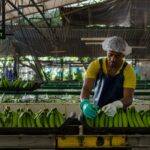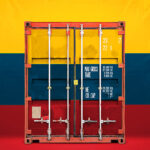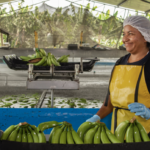Colombia's mango de azucar and its potential in the United States market

The first days of May marked a milestone for Colombian agroexports. For the first time, mango de azucar was shipped to the United States via maritime route. A total of 13 tons were sent from Santa Marta, Colombia, to the Port of Savannah, Georgia, with the sector hoping that this will be the first of many.
For more details on this important milestone for the Colombian fruit sector, Portalfruticola.com exclusively interviewed the CEO of Seasons Farm Fresh INC., Nicolás Bernal, who analyzed the mango de azucar production, a fruit that is exclusively produced in Colombia to date and has great growth potential in the United States.
How do you view the production and export season of Colombian mango to the United States?
"It seems we are going to have an interesting season with mango de azucar. I'm not sure if we'll reach the volume we want, but we will have very interesting exports to the United States, both with mango de azucar and conventional mango. It has been challenging so far, due to climate change and the El Niño weather phenomenon. The mango season has been delayed about a month and it could be up to six weeks depending on the region of the country."
What analysis do you make in comparison to previous exports?
"We were the first to export Colombian mango to the United States in December 2022. Since then the volumes have been growing. We have potential in the American market, there is Mexico and other countries with more competitive prices, what is happening in the country regarding red mango is that there are more orchards in the certification process. Since, to send mango to the United States, you must have a certified property approved by ICA and USDA standards."
"So there are more plots in the process that are meeting the requirements, so there is more volume available for export. That will increase the volume and I think it will continue to grow year by year. Producers who are thinking of sending their mangoes to the US market will have to adjust and modify the flowering as well as their programs, so that the mango is available at the right time."
In what areas of the United States are you currently marketing mangoes?
"We are located in Miami, but we have distribution and logistics channels in almost the entire country. Colombian mango is actually present in states such as Boston, New York, Philadelphia, Chicago, Texas, Los Angeles, and California."
What is the commercial strategy to ensure that Colombian mango qualifies and becomes the choice for the buyer?
"When we talk about Colombian mango, we must separate two classes of mangoes, there is red mango, which is well known worldwide with varieties such as Keitt, Kent, and Tommy, which are consumed almost daily. Additionally, in the United States, people do not give much importance to the country of origin of mangoes, so when red mango is in season, it mainly comes from Mexico, when Peru, Ecuador, and Brazil are in season, mangoes are coming from elsewhere in the world. So the consumer really does not have a preference for red mango coming from Colombia, Peru, or Ecuador, buyers are looking for price. That's why there are certain windows when there is low production in Mexico, Peru, Brazil, or Ecuador where Colombian mango can compete due to its proximity."
"The mango we are focusing on now is mango de azucar, it is unique because it does not exist anywhere else in the world. We are promoting it along with ProColombia, Asohofrucol, Fedemango, and all exporters. Together with the guild, we are promoting mango de azucar as Colombian mango, as it is a fruit that only exists here in Colombia. It is a tiny mango, with a high level of bricks, and it is very special because it only comes from the Colombian coast, from small properties."
What is the production window in Colombia?
"mango de azucar was a bit delayed at the start of the season, but we have already made the first shipment to the United States. Normally the season is from the second half of March to the first half of July. But it all depends on the rains and when the fruit fly arrives because according to US regulations, ICA regulations, and the treaties between the two countries, fruit cannot be exported when there is fruit fly present in the area."
What is the commercial objective you expect for this harvest?
"Mango shipments were focused on the coasts of New York, Miami, Texas, and California where there is a lot of influence from Latinos, Asians, and many foreigners who consumed the fruit in their countries. The central part of the United States was not a very large consumer population. Now in the last 15 years, thanks to the work of the National Mango Board, fruit consumption has been promoted. Every year I see more and more interest in mango, it is the number one fruit in the world in terms of consumption. I see supermarkets promoting its consumption a lot and this will continue to grow among young consumers, as well as for ingredients for chefs, in restaurants, and hotels."
How do you see the fruit fly control at the industry level?
"Colombia as an exporting country is still very young, it has not been in the mango export business for long. I believe in the estates in Antioquia, and the estates in Ayapel, which are between 50 to 100 hectares, generally owned by entrepreneurs, and they are making large investments to protect their fruit against fruit flies and pests. When we talk about red mango, Colombia is super advanced, but with mango de azucar the estates are smaller from 1 to 3 hectares because they're not in high demand locally. That is improving now, but there is still much to do, we are on the way and we are working well with Asohofrucol and with the producers, since the American market has opened."
Last year you made your first export. What progress have you seen during this time and what obstacles have you encountered? What do you recommend as an entrepreneur for growth?
"The key to the business for us, for the producer, and for anyone involved in mango export to the United States, will always be phytosanitation. For example, if we are exporting 1,000 boxes, we have to present 20 boxes to ICA for inspection and sampling. In addition, they have to take a number of fruits and cut them to ensure that there are no fruit flies. The most difficult part is how we are going to control and prevent the insect, and that is key to this business."
How do you work with small producers?
"I now have two partners, with two exporters where we are working hand in hand with them, we provide financial muscle and obviously do the imports. Regarding large mango producers, we are always in contact with them, visiting estates, assessing, we are directly in contact with agronomists to schedule harvests."
"With large farms, there is not so much need to be present all the time. In the case of mango de azucar it is more complex, we have two people who are 100% dedicated to being in the estates every week, they are in the packing houses and throughout the process until the plane leaves the airport for the United States."
"The mango we export has a maturity grade 3; they are starting to change color but are firm, and this mango, with cold storage, lasts two weeks. The other mango varieties last a month, so we send everything by sea.
"mango de azucar is very fragile due to its sugar content, it can't withstand much time through maritime transport. This year we are going to conduct some tests because if we succeed with that logistics, we'll open up a larger market, reducing costs. We are currently paying $2 per kilo in freight, plus transportation.
How would you define the United States consumer?
"Last year we made three shipments of 8,000 boxes of 2 kilos each. Now there's a high demand for mango de azucar because it's a small, sweet mango. So we are targeting a higher-end market.
What's the business projection for the next few years?
"I've been in this business for almost 13 years, and I'm very interested in opening up new markets Colombian products. We are aware that mango has a very interesting future for export. I am working with ICA and the American government to open up more doors; I believe the next ones will be passion fruit, maracuya, gulupa, and granadilla.
"The problem of accessing the American market depends on the deals between countries, which sometimes have nothing to do with phytosanitary issues. There is a great need to invest in a papaya industry for export to the United States. My focus is to see which products are truly unique, very niche in Colombia, and promote them with ICA, the Colombian government, ProColombia, and the United States to open up markets, for example, with passion fruit."
"We are already starting the mango de azucar campaign, and we need the support of the government, the entire guild, all producers to come together and focus on producing a decent, good, and healthy fruit, so that we, as marketers in the United States, can reach supermarkets and customers with a Colombian product.
"mango de azucar only exists in Colombia, so my advice is that Colombians should protect mango de azucar as a national brand and continue to promote the product as super Colombian and continue to produce a quality product."










































